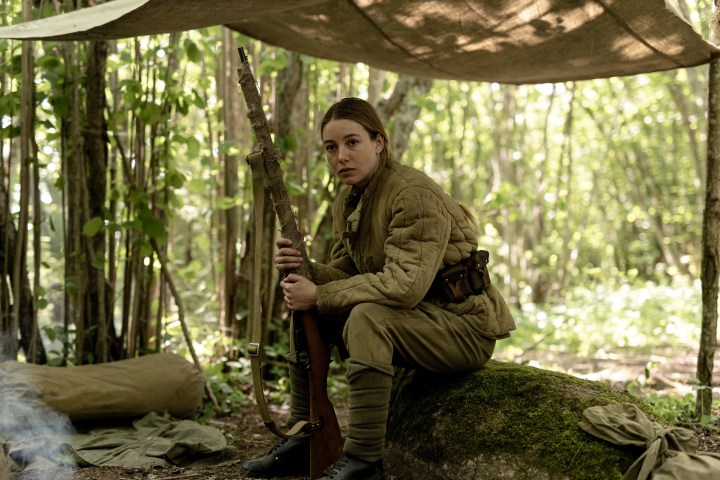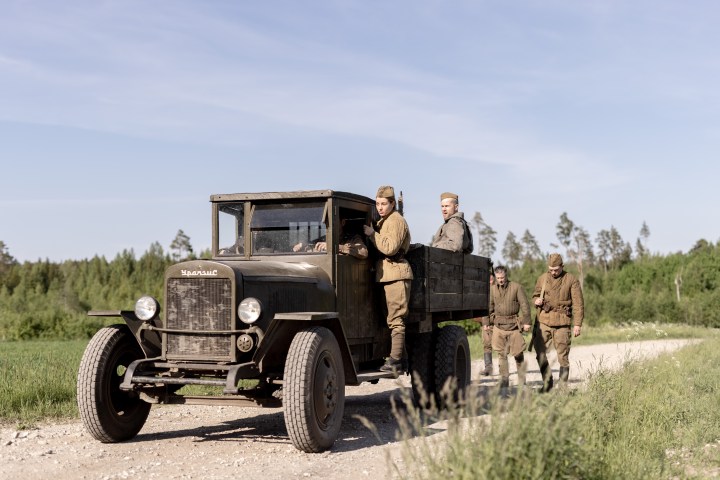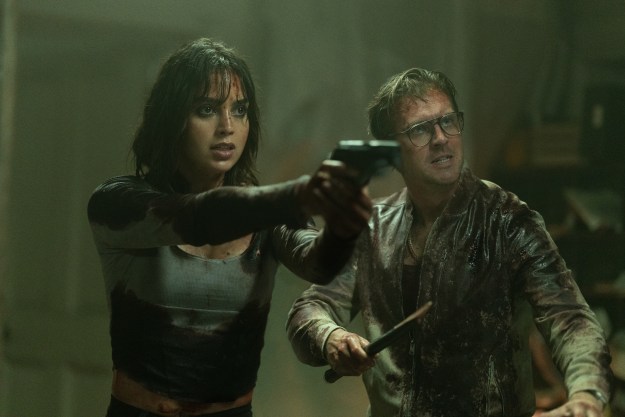Ben Parker poses an interesting moral dilemma in his new film, Burial. What would a person do if they came into contact with the remains of Adolf Hitler? For Russian soldier Brana Vasilyeva (Charlotte Vega), that hypothetical becomes a reality when her unit is tasked with transporting Hitler’s remains out of Germany and into Russia in 1945. However, a group of German Nazi soldiers known as “werewolves” interrupt the transport, leading to a violent confrontation over the body of the deceased dictator.
According to Parker, who serves as both the writer and director, the hunt for Hitler’s body is like searching for a buried treasure. Once you find the treasure, it “turns people crazy” and leads to corruption. In conversation with Digital Trends, Parker explains the origins of Burial, his curiosity for WWII history, Charlotte Vega’s riveting performance, and the status of indie filmmaking in 2022.

Note: This interview has been condensed and edited for length and clarity.
Digital Trends: What was the basis for Burial? I believe you were finishing this script while promoting The Chamber.
Ben Parker: I was, yes. How did you know that? That’s good research. I stood up onstage when I was showing The Chamber, and you get the question, “What’s next?” I said, “Well, this is the film I’m going to do next.” And then it took five years to get it off the ground. The story, the seed of it, happened before my first feature.
I was writing lots of different scripts, and I was researching and writing a script about a different Russian figure who turned against Stalin, which was interesting. He was called a traitor because he turned against Stalin, and then was one of the people that tried to save Prague at the end of the Second World War. I thought that was really interesting.
But as a side note, I found in one of the books this note about the burying of Hitler’s remains at the end of the war. Well, now I’m looking at that. I’m researching that. That’s interesting. The thing that I was doing was a sort of biopic drama, and then this came up. I thought that idea is so visual – what happens to a person when they have to find the remains of Hitler, bury them, and dig them back up – what it must do to someone.
So that gestated for a while. I hadn’t yet done my first feature so I didn’t think I could spin it out into a feature; I thought it would be a nice short. When I did my feature, I thought, “No. I’m going to sit down to write this into a feature. It’s a really good idea.”
You compared Burial to The Treasure of the Sierra Madre, but with a body instead of gold. It’s also a tale about morality. Why did you decide to go that route when telling this story?
There’s a nod at the very start of the film as well. There’s a TV announcer who says, “The Treasure of the Sierra Madre is going to be on the TV.” It’s such a great film. I’m obsessed with stories about gold and buried gold as well. Gold, even though it can be used as a good thing, is one of those things that makes people crazy. They see it and they go crazy. They find it and they go crazy and it corrupts.
I thought that’s just a great allegory for this because this horrible person who’s now dead is going to corrupt everybody around him still. He needs to be burned and gotten rid of. The characters say they want people to see that he’s dead, and people who want to get rid of him kept it secret. That sensibility of a buried treasure, and it’s hard to say buried treasure because it’s the opposite of treasure, has that same effect on people. It turns people crazy.
Did you know much about German “werewolves” before writing the script? Were you a WWII history buff?
All the men in my family are military so you just get that shoved down your throat to some extent. [Laughs] All the women are teachers or nurses and all the men are soldiers. My grandfather and my dad just hoover up that stuff and regurgitate it to me. So I knew a bit about it, but I didn’t know about werewolves.
I didn’t know about their werewolf, and that was something I discovered when I found the origin of this story so I researched that as well. There are a couple of great books on it. There’s a lot of literature that’s genre horror. What a great name to turn this into a thing. I think John Landis knew that when he was doing An American Werewolf in London. There’s like Nazi werewolves and stuff.
But the real werewolves were also fascinating, and highly overstated for their numbers. They were not a big military force at all because Germany had basically bled everybody dry. But what was fascinating was when I went to film in Estonia, we were saying that these guys [werewolves] were the bad guys. Then in Estonia, they had a similar faction called The Forest Brothers. I’m like now I have to find out all I can about the Forest Brothers. They were a similar guerrilla force hiding in the forests, living off the forest, but fighting against the Soviets. And that’s an interesting story as well.
You were going to call the film Werewolves?
[Laughs] I did. It just confused people. Initially, I wanted to talk about real things. I also wanted to talk about people who make up stories, propaganda, or a myth and people who use myths to control people. Some of the nicer elements of myth are legends and folk and this kind of thing. But I wrote it through the lens of these mythical creatures.
There were the werewolves, and then there were the vampires. The vampires who want to suck the blood of everything dry. They’re leeches. They don’t care about anything. The werewolves would come out at night, covered in hair, and play into these visual elements of myth. I thought would be a really good idea to call the movie Werewolves because people would think, “Wow, werewolf!” But that’s exactly what they did. They thought they were going to watch a werewolf movie. [Laughs]
In general, war films do not have many women in the leading role, but Burial is built around Charlotte Vega’s character, Brana. How did that decision to build around Brana come about?
I’m drawn to those types of stories. I’m drawn to strong female characters. It could be a blessing or it could be a curse. You could get a lot of war film fans to say, “I’m not going to watch a film with a woman,” but I like those stories. It was also a great sort of benefit to me to have someone who is more sympathetic to the central part of the story.
It revolves around Russian soldiers at the end of the Second World War. I knew that I definitely didn’t want to be wholly glowing about the Soviets and their behavior. I wanted to make sure that we said what really happened. So having this character of Brana helps with the sympathies of the audience. She is someone you can root for.
When did you know Charlotte was the right actor for the job? What impressed you about her performance?
I saw her in a friend’s film called The Lodgers, and I thought she was fantastic. She and Bill Milner did the film together, directed by Brian O’Malley, which is a great film. I thought she was the actress to go for, and I put her on a very, very short list at the very beginning of the process and said, “I want her.” And invariably, what happens is lots of other people say we should try this and try that, and luckily, it came back to one of my top picks.
I just saw something in those performances. She was in the reboot of Wrong Turn, and she’s really great. She has a good ability to be tough, but also shows the sensitive side of things, not through being weak, but by a look or thing. The audience sees it. It’s great. It’s like magic. I don’t understand acting at all, but when you see it, you know it’s great.
Charlotte had a great line in the film when she’s in the barn with Lukasz and says she knows what it’s like to be “surrounded by wolves.” Despite having the Germans and the werewolves as enemies, she still feels on edge around her allies.
Yeah. I love that moment of hers as well. I wish I could take credit, but I did not direct her in that way. She did that line a couple of times, and the one that we use in the film, she slightly nods to the question. He says, “You know what that’s like, to lose someone?” She slightly nods so the audience catches it. She says, “Yes,” but she says something else, and I think that’s amazing. Whenever I see that in a film or TV, when you say something and then you say something else in a look, it’s just great. It gets across twice as much, the deep horror in her past, by that little look that she does. It’s great.
Why did you decide to frame the story through a flashback? Was that always the plan?
Yeah, it was always the plan. I wanted to start it in 1991. Again, you’re making it harder for yourself because you should probably set it as a bookend in the present time. It’s easier to do production design. But to set it in 1991, that moment in history where everything came down and people were saying, “Great! It’s finished. It’s over. Isn’t that great?” And right then and there, something happens that a character can say, “I know how this goes. It can always grow back if you let it grow back.”
It was important for me to do that. To show that point, things can grow back if you let them. You need to stay on this. Also, I like when someone is telling me a story. I like it when there’s a character who tells me a story. I shouldn’t do it all the time. I’m not going to do it in every film, but that’s a nice way to get into it.
You made a small claustrophobic horror. You wrote a haunted house horror. Now, you have Burial. What’s your next progression as a filmmaker?
I love sci-fi. I love reading sci-fi, and I love like Philip K. Dick and stuff like that. I’d love to do something science fiction. I think that opens up a lot of avenues. I really like that. Yeah, I’m an open book. I’ve done a really good horror film. I’ve done two thrillers with touches of horror and I’ve got a horror film that hopefully is going to happen. But that’s really fun for me. I think from most scripts, I’m coming from a position of horror, even when it’s a thriller. I want to thrill you with scares. I want to thrill you with horrific stuff. It’s all about tension. You know, I love Brian De Palma so I’d love to do a sort of horror.

What is the status of indie filmmaking today? It seems like every other week, there are opinion pieces on how IP and superhero films dominate theaters or how projects that would have been indie films years ago now become television shows. But, there are still indie filmmakers making good work.
It’s all about the audience and what they watch. If you’re just happy to watch IP, then that’s what people are going to make. It’s difficult after COVID, getting back out and actually making the effort to go to the cinema and see indie films and championing those indie films and saying, “This is really good.” There have been some really nice breakout hits of indie films, and it’s great. It’s really heartening to see it when that happens.
I don’t think there’s anything wrong with doing stuff on IP. I just think that if the cynical option is “let’s get some IP that everybody knows,” it’s harder for a filmmaker or writer to do something new with that. What I love is IP that everybody’s forgotten about, a really old story that people haven’t seen on the screen for a while. But that’s not really why they’re seeking IP. Taking Aladdin and turning it into a horror film, nobody wants to see that.
That’s interesting.
You can get bored with superheroes and stuff like that, but people still like it. I still watch it. It’s fun. But the ones that you like, the ones that do a little bit more with it, give you something you haven’t seen. I think it’s good until the money comes away from indie films and the money starts drying up and streamers are not putting back into any film. You need a proving ground. You need a part where filmmakers can grow. It’s difficult, sometimes, doing that in long-form TV. Films are usually the most, sort of purest, form of what the filmmaker’s thinking. You need a lot of money going into indie films.
Burial opens in select theaters and on demand on September 2nd.
Editors' Recommendations
- All Jacked Up and Full of Worms director talks psychosis and morality
- Director Petr Jákl on making Medieval, a Czech Braveheart with Michael Caine
- Burial trailer pits the Russians vs. the Nazis in WWII
- Like A Rolling Stone’s director on Ben Fong-Torres’ legacy




